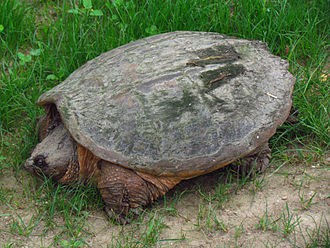Type the name of the breed you're looking for below
[wpdreams_ajaxsearchlite] Don't see the breed your're looking for? Click here and let us know!
American Snapping Turtle
| Place of Origin and Range | Its natural range extends from south eastern Canada, southwest to the edge of the Rocky Mountains, as far east as Nova Scotia and Florida. This species and the larger alligator snapping turtle are the only two species in this family found in North America. |
| Description | The snapping turtle is noted for its belligerent disposition when out of the water, its powerful beak-like jaws, and highly mobile head and neck. Brownish in colour with a relatively smooth carapace and a tapering tail. |
| Morph Patterns Available | Yes |
| Adult Size | Can grow up to 19 in ( 47cm) |
| Accommodation | The common snapping turtle is not an ideal pet. Its neck is very flexible, and a wild turtle can bite its handler even if picked up by the sides of its shell. The claws are about sharp and dangerous as those of dogs but cannot be trimmed as can dog claws. Veterinary care is best left to a reptile specialist. A wild common snapping turtle will make a hissing sound when it is threatened or encountered; however, when in the water and unprovoked, they are fairly docile toward humans. |
| Lifespan | Can live 100+ years |
| Feeding / Diet | The common snapping turtle is an aquatic ambush hunter, capturing its prey with its beak-like jaws. Mainly fish. |
| Other Considerations | Watch for theses health concerns carefully with your turtle. Vitamin A Deficiency: Vitamin A is an important nutrient for your turtle’s health. It is found in his diet in the form of leafy green, orange or yellow vegetables, liver, and fish. If your turtle is not getting enough Vitamin A, he can suffer serious health problems. Always check to make sure that your turtle does not have swollen eyelids, as this is the main sign of a Vitamin A deficiency. Also, check for weight loss, nasal discharge and infected skin. Any of these symptoms could point to a deficiency. If you think your turtle may not be getting enough Vitamin A, you should take him to the veterinarian to get a firm diagnosis. Shell Problems: Your turtle’s shell is very important to his overall health. There are many potential problems that could occur, so you should be on the lookout at all times. Respiratory Disease: Respiratory infections have symptoms similar to vitamin A deficiency, including swollen eyelids and runny nose, so you should take your turtle to the veterinarian to get a proper diagnosis if you suspect either. More serious infections will be characterized by breathing through the mouth, mucus in the mouth, and wheezing. Always make sure your turtle’s environment has the proper amount of humidity, as this will help prevent respiratory problems. |



